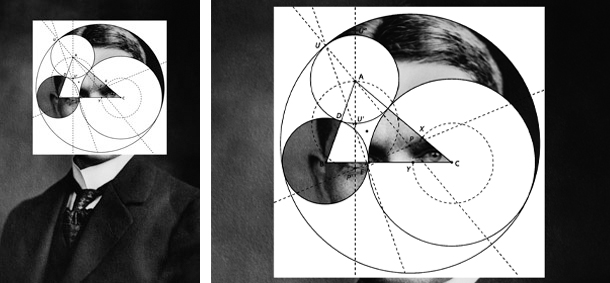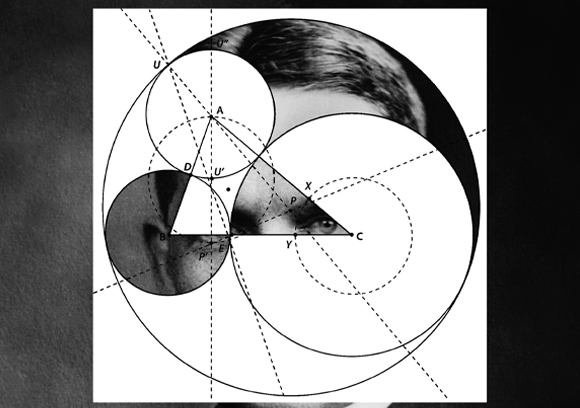| |
|
|
41.
| Soddy |
| |


2014, pigment print on baryta, 30 x 20 cm.
Exhibition view from Constructing Illusion, Analix Forever, 2015, Geneva.
Courtesy of the artist and Analix Forever, Geneva.
Ed. of 5 + 2 A.P.
'' The power of his piece owes a great deal to this continuous/discontinuous energy, and convinces us
that it is something other than a simple borrowing from a foreign universe. Everything is tangency or tends towards tangency. ''
Régis Durand, 2014

Soddy
Exhibition view from Constructing Illusion, Analix Forever, 2015, Geneva.
Courtesy of the artist.

Soddy
Exhibition view from Constructing Illusion, Analix Forever, 2015, Geneva.
Courtesy of the artist.
|
|
|
|
|
| Collection of Mirabaud Contemporary Art Collection, Geneva
« Soddy » se présente comme une série photographique en noir et blanc dont le sujet disparaît en partie derrière des compositions géométriques. Le portrait est celui de Frederick Soddy, mathématicien et chimiste, auteur du poème « The Kiss precise », inspiré du théorème de Descartes sur les cercles tangents. L'image du savant provient d'une photographie officielle réalisée l'année où lui a été remis le prix Nobel de chimie, en 1921. La superposition d'une composition géométrique au portrait constitue une illustration des propriétés géométriques des cercles tangents, où apparaissent droites et cercles noirs tracés sur un fond blanc au format carré. Lignes et courbes s'entrecoupent pour former des figures géométriques complexes, qui s'ouvrent par endroits, ne laissant voir qu'en partie certains détails anatomiques de la figure du savant : fragment d'oreille, d'œil, de front. Elle livre aux regards une vue parcellaire dont l'énigme fait écho à l'histoire de l'élaboration de la bombe atomique telle qu'elle est évoquée par le critique d'art Régis Durand qui la relie aux travaux de mounir fatmi, suite improbable de réactions en chaîne faisant appel à des composants pour le moins inattendus : « Celui à qui en reviendrait l'idée, Leo Szilard en 1936, aurait été mis sur la voie par le souvenir de sa lecture d'un roman d'anticipation de H.G. Wells de 1914, The World set free. Wells à son tour se serait inspiré de travaux scientifiques déjà en cours, et notamment ceux de Soddy sur la désintégration de l'uranium au début du 20e siècle (…) » (The Kiss precise, « Une construction continuée », 2014).
Mise en dialogue des arts photographiques et picturaux et des mathématiques, du figuratif et de l'abstraction, la référence au poème de Soddy est fréquente dans les œuvres de mounir fatmi. Elle permet d'introduire le spectateur à une étude des correspondances artistiques et se trouve au fondement d'une métaphore plastique filée par mounir fatmi à travers plusieurs installations et sculptures, à savoir le « Baiser », comme réponse à un désir de réaliser un programme esthétique où rigueur formelle et sensibilité poétique s'harmonisent. Les résultats de cette recherche d'équilibre sont également observables dans des œuvres telles que « Kissing circles », « Les Affaires des sphères » ou « Le Baiser précis », parmi d'autres. La série de photographies « Soddy » maintient dans le même espace abstrait et figuratif, sans exclure ni l'un ni l'autre, de telle manière que le portrait semble inachevé, en cours de réalisation, et ce, sous les yeux mêmes du spectateur. Cet aspect mobile, voire polymorphe de l'œuvre, pourrait rappeler l'action painting de Pollock, source d'inspiration importante pour mounir fatmi : procédé qui insiste sur l'importance du geste créateur, sur l'élaboration de l'œuvre d'avantage que sur son résultat définitif. Le « recouvrement » au moyen de motifs géométriques et l’« effacement » de la figure du poète et savant relèvent également d'une stratégie artistique que mounir fatmi a élaborée à partir des techniques de dripping et de all over développées par Pollock. Elles viennent contester, remettre en question l'aspect figuratif du portrait. Elles recomposent un visage au chimiste, désormais fait d'une multiplicité de formes en mouvement. Le portrait photographique de mounir fatmi restitue une forme vivante par inoculation du charnel dans le géométrique et greffe du géométrique sur le charnel. Il constitue une tentative de représentation du sujet vivant et désirant.
L'œuvre définit finalement son propre rapport à la référence culturelle, intellectuelle ou artistique. D'un côté, par le jeu des formes géométriques surajoutées, elle met à distance l'autorité figurative : elle réintroduit de la mobilité et du jeu dans le portrait, et gagne ainsi en indépendance et en autonomie. De l'autre, elle rend hommage au géomètre capable d'allier poésie et recherche formelle, et elle met au point un masque, un être quelque peu surnaturel, dont l'appareil sensoriel est entièrement concentré dans deux sens, à savoir l'ouïe et la vue, afin de percevoir les plus subtiles variations rythmiques. Le masque Soddy apparaît comme un père spirituel et comme l'inspirateur de recherches esthétiques alliant sensibilité poétique et formalisme. Il est l'esprit de l'abstraction géométrique telle qu'elle se conçoit dans le programme esthétique de mounir fatmi.
Studio Fatmi, février 2017.
|
|
« Soddy » presents itself as a series of black & white photographs whose subject is partly hidden by geometric compositions. The portrait is that of Frederick Soddy, a chemist and mathematician and author of the poem « The Kiss Precise », inspired by Descartes’ theorem on tangent circles. The image of the scientist comes from an official photograph made in 1921, the year he received the Nobel Prize in Chemistry. The superimposition of a geometric composition on the portrait illustrates the geometric properties of tangent circles, with black lines and circles drawn on a square white background. Lines and curves cut across each other and form complex geometric figures that open up in places, partly exhibiting certain anatomical details of the scientist’s features: a fragment of an ear, an eye, the forehead. They only let a partial view show whose mystery echoes the story of the elaboration of the atomic bomb as evoked by art critic Régis Durand, who connects it with Mounir Fatmi’s work: an unlikely series of chain reactions based on unexpected components, to say the least: « The one who had the idea, Leo Szilard in 1936, is said to have been inspired by reading a 1914 futuristic novel by H.G. Wells, The World Set Free. Wells himself was allegedly inspired by scientific research of the time, including Soddy’s work on the disintegration of uranium in the early 20th century » (The Kiss Precise, « A Continued Construction », 2014).
Establishing a dialogue between photographic and pictorial art and mathematics, between figuration and abstraction, the reference to Soddy’s poem is frequent in mounir fatmi’s work. It allows him to introduce the viewer to a study of artistic correspondences and it’s at the heart of an extended plastic metaphor by mounir fatmi spanning several installations and sculptures, among which « The Kiss », responding to the desire to create an esthetic program where formal precision and poetic sensitivity combine harmoniously. The results of this quest for balance can also be seen in pieces such as « Kissing Circles », « Spherical Affairs » and « The Kissing Precise », among others. The « Soddy » series of photographs hold in the same space the abstract and the figurative, without excluding one or the other, so that the portrait seems unfinished, like a work in progress conducted before the viewer’s very eyes. This mobile, polymorphous aspect of the work is evocative of Jackson Pollock’s « action painting », an important source of inspiration for mounir fatmi: a process that insists on the importance of the creative gesture, on the elaboration of the work of art rather than on the final result. The « covering up » with geometric motifs and the “erasing” of the figure of the poet and scientist are also part of an artistic strategy that Mounir Fatmi has elaborated based on the techniques of dripping and all-over developed by Pollock. They are used to contest and question the portrait’s figurative aspect. They recompose a new face for the chemist, now made of a multitude of moving shapes. mounir fatmi’s photographic portrait delivers a living entity through the inoculation of corporeality into geometry and the transplant of the geometric onto the corporeal. It constitutes an attempt to represent a living and desiring live subject.
Lastly, the work defines its own relation to cultural, intellectual and artistic references. On one hand, with the combination and accumulation of geometric shapes, it distances itself from the authority of figurativeness: it reintroduces mobility and play into the art of the portrait, thus gaining independence and autonomy. On the other hand, it pays homage to a geometrician capable of combining poetry and formal research; it elaborates a mask, a slightly supernatural being with sensory functions entirely focused on two senses: hearing and seeing, in order to perceive the most subtle rhythmic variations. Soddy’s mask is revealed as a spiritual father and as the inspirer for esthetic research that combines poetic sensitivity and formalism. He is the spirit of geometric abstraction as conceived in mounir fatmi’s esthetic program.
Studio Fatmi, February 2017. |
|
|
|